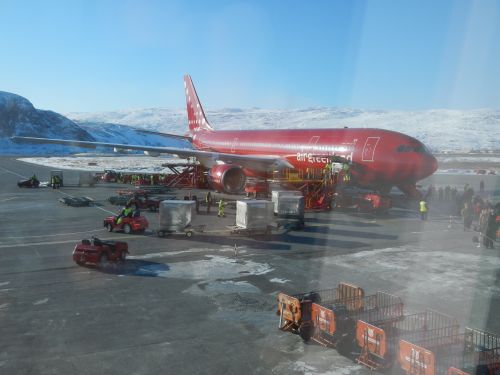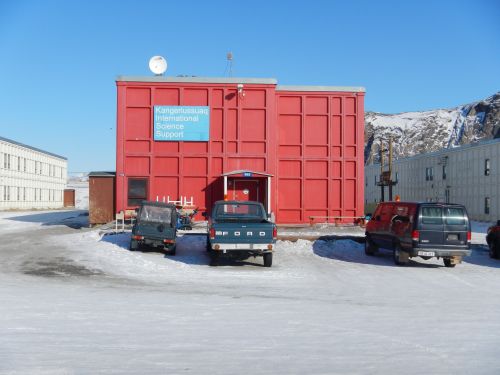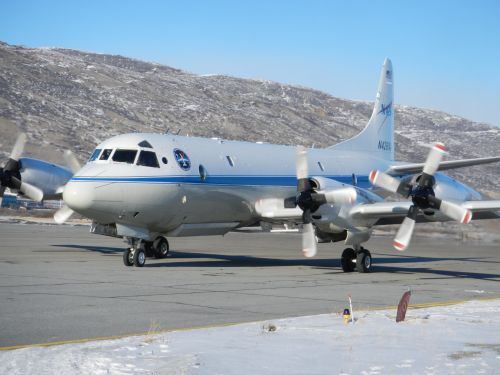On to Kangerlussuaq
I was surprised to see that my plane flying to Kagerlussuaq (pronounced Kanger-loo-swak) is the exact same model (A330 - which is a widebody) that flew me from Minneapolis to Paris. Why such a need for that kind of capacity? After all, Kanger has a population of about 500 residents or so. The jet would be carrying about half again that number of people.
During the flight I worked my way through my complimentary copy of "Greenland Today," a business-oriented publication, and "Suluk" - meaning "wings," the official magazine of Greenland Airlines. The airlines pages in the back of "Suluk" told me all I need to know. Air Greenland has 32 aircraft in their fleet. One of those is a jet - the one I was on. Twenty-one of those are helicopters while the rest are turboprops. The only air connection between mainland Europe and Greenland is through Kanger as it has the only airstrip long enough to support large aircraft. This tiny community is the travel hub of the entire country. Once in Kanger people then take commuter flights to the rest of the country and, sure enough, just after we landed a turboprop took off toward the capital, Nuuk.
In my journal from 4/5 I discussed the possibility of flying "as fast as the sun." Today I left Copenhagen at 9 am local time, flew for 4 hours and 40 minutes, and then landed at 9:40 am local time. We did not quite keep up with the sun in this case, but we weren't far behind.
The town of Kanger evolved as a US air base during WWII, transformed into an important air base/tactical facility during the Cold War (along with Thule, in the far north of the country), and faded into irrelevance as the Cold War ended. Left behind is a town that relies almost entirely upon the airport for its economy.
 The lone Air Greenland jet, the A330, has arrived in Kanger
The lone Air Greenland jet, the A330, has arrived in Kanger
When I arrived nearly everyone associated with Operation Ice Bridge was out on the plane. Nonetheless, a couple of folks stayed behind to gather myself and a few others and take us back to our living quarters at KISS - Kangerlussuaq International Science Support. This barracks-style dormitory, like nearly every other large building in town, was constructed by the US military back in the day. The simple, box-like design suggests the efficiency of a military architect.
 The KISS dorm where I will be living. I like the red.
The KISS dorm where I will be living. I like the red.
Around 4:30 pm the P3-Orion arrived.
 My first view of the P3 Orion as it lands after a day of flying.
My first view of the P3 Orion as it lands after a day of flying.
You'll note that the plane parks on the ramp as there is no hanger around to house it. Since the overnight temperatures have been dropping to about -15F this lack of a hanger becomes a bit of a headache. The four engines must be warmed before then can start. And yesterday morning it was so cold that the engine warmers themselves had to be warmed before THEY would start. This is why flight preparations begin at 5:30 am each day for a scheduled departure at 7:30 am.
I only had a brief introduction to the crew before we headed off to dinner together. The airport runway divides Kanger into two parts: the north side ("downtown") centers around the airport terminal while the south side represents the more rural subdivision. The KISS facility is located on the south side next to an elementary school and another science support buliding. On our side of town there is exactly one option for dinner, the Polar Bear restaurant. It serves pizza, Thai cuisine, and a few sandwiches.
Now when I visit a Thai restaurant for the first I like to order my usual - a standard, straight forward Thai dish that let's me know what caliber of restaurant I'm dealing with. So when my Thai muskox noodles arrived I had to say that it tasted a little "gamey" but wasn't all that bad. At least there were no hairs in my dish, and that's not easy to accomplish with Muskox.
While there, a native hunter stopped by to grab a bite, his rifle slung over his back. Nice local touch!
I hope to get some interviews with various crew members tomorrow and put together a better picture of exactly how Operation Ice Bridge functions. Stay tuned.


Comments